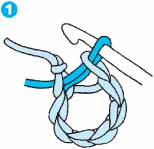
CROCHETING BACK AND FORTH IN ROWS is not the only way to go! Many crocheted pieces are worked in rounds rather than rows. This method produces both flat motifs, such as granny squares, and seamless three-dimensional items, such as hats.
Q How do I start a flat piece in the round?
A The technique for working a flat piece in the round is the same whether you want your finished piece to be a circle, square, triangle, or other shape:
1. Start with a crocheted chain, and then join the chain with a slip stitch to form a tiny circle (called a ring).
2. Work a beginning-of-the-round chain to raise the hook to the correct height for the first round, depending on what height stitch you plan to work. Work the first round into the ring.

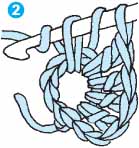
Q How many stitches should be in my starting chain?
A It’s usually 4 or 5 stitches, just enough to get the required number of stitches into the ring on the first round, but no more. That number is surprisingly fewer than you might think. In general, a joined chain-4 ring easily holds 8 stitches. A chain-5 or -6 ring holds a dozen or more stitches.
Q Can I make a large hole in the center of the piece?
A Just start with a longer chain and put more stitches into the ring on the first round. Feel free to experiment with different numbers of chains in your starting ring.
Q What does it mean to work into the ring?
A Instead of putting your hook into a chain stitch, as you do for back-and-forth crochet, put your hook into the center of the ring and pull up a loop around the chain. As you work the stitches, hold the yarn tail near the chain and work around it as well to secure the tail.
SEE ALSO: Pages 151–52, for starting a flat piece.
Q How many stitches go into the first round?
A That depends on both what you want your final shape to be and the height of your stitches. The taller the stitch, the more stitches you need to put into the first round. Here’s why: The larger a circle’s diameter, the longer its circumference. The circumference of the circle is measured at the top of the stitches. Because taller stitches create a wider circle as compared to smaller stitches, more stitches are required to make a longer circumference. You’ll note that the taller stitches may be crowded together at their bases, but spread out at their tops to form a circle.
SEE ALSO: Page 143, for formulas.
Q What happens at the end of the first round?
A You have two choices: either closing the round or working in a spiral. When you close the round, you join the last stitch in the round to the first stitch with a slip stitch.
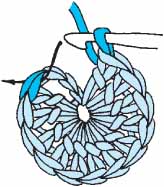
closing the round
You may also keep working in a continuous spiral without closing the round. Be sure to place a marker in the last stitch of the round and move it out on each subsequent round so that you know where the beginning of the round is. You still have to work increases on each round of the spiral in order to keep the piece flat.
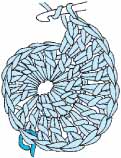
working in a spiral
Q How do I keep my motif flat?
A Each subsequent round requires a number of increases in order to keep the piece flat, because as a circle gets larger, more stitches are needed to fill the widening circumference.
Q How do I determine how many stitches to increase each round?
A The height of the stitches determines the number of the stitches you need to increase on each round. The taller the stitches you are working, the more increases you need to make.
SEE ALSO: Page 143, for formulas.
Q Where do I put the increases?
A The placement of the increases determines the shape of the motif. When you space the increases evenly, you create a circle. If you group the increases at four equidistant positions, you create a square. You can make other shapes by placing increases at other points.
SEE ALSO: Pages 142–43, for circles; pages 143–44, for squares; page 144, for other shapes.
Q What kind of increase should I make?
A Any kind you want. You may work multiple stitches into the same base stitch, make one or more chain stitches, or use a combination of stitches and chains.
Q How do I make a flat circle?
A If you start with the correct number of stitches in the first round, it is fairly simple to keep up with the required increases. Increase in every stitch on Round 2, every other stitch on Round 3, every third stitch on Round 4, and so on.
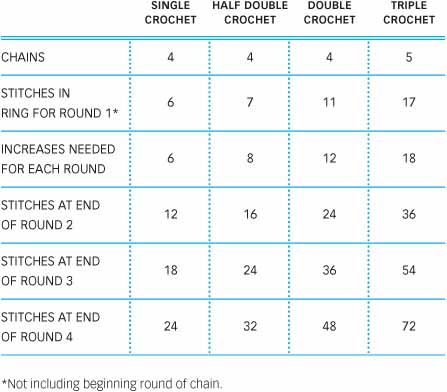
Note: In half double, double, and triple crochet, the beginning-of-the-round chain is counted as a stitch; in single crochet it is not.
Q How do I make a flat square?
A Begin with a chain ring as for a circle, but instead of spreading out the increases evenly, group all the increases at just four locations evenly spaced around the ring.
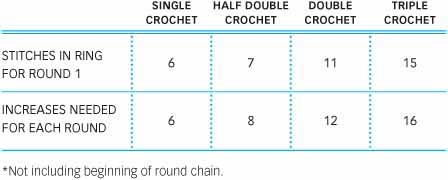
Note that a single crochet square offers special challenges, since you need to space six increases evenly at four locations. You can play with the math until it works out for your design: Put 12 increases evenly spaced every other round or increase 6 every round, alternating the corners where you put double increases.
Q How do I make other flat shapes?
A You can make triangles, hexagons, and other flat shapes following the same system as for a square. Begin with a chain ring and group all the increases together: in 3 spots for a triangle, 6 for a hexagon, and so on. You may need to change the number of stitches in your starting ring or your first round in order to make the stitch counts work out evenly.
Work through Round 1 of a single crochet flat circle.
RND 2: Ch 1, *3 sc in next sc, sc in next sc; repeat from * one more time, 3 sc in next sc, join.
RND 3: Ch 1, sc in next sc, * 3 sc in next sc, sc in next 3 sc; repeat from * one more time, 3 sc in next sc, sc in next sc, join.
RND 4: Ch 1, sc in next 2 sc, * 3 sc in next sc, sc in next 5 sc; repeat from * one more time, 3 sc in next sc, sc in next 2 sc, join.
RND 5: Ch 1, sc in next 3 sc, *3 sc in next sc, sc in next 7 sc; repeat from * one more time, 3 sc in next sc, sc in next 3 sc, join.
Ch 4, join with slip stitch to form ring.
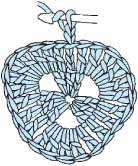
variation on double crochet triangle
RND 1: Ch 3 (counts as dc), 11 dc in ring, join. [12 dc]
RND 2: Ch 3, dc in next 2 dc, *5 dc in next dc, dc in next 3 dc; repeat from * one more time, 5 dc in next dc, join. [24 dc]
RND 3: Ch 3, dc in next 4 dc, *5 dc in next dc, dc in next 7 dc; repeat from * one more time, 5 dc in next dc, dc in next 2 dc, join.
RND 4: Ch 3, dc in next 6 dc, *5 dc in next dc, dc in next 11 dc; repeat from * one more time, 5 dc in next dc, dc in next 4 dc, join.
A An oval or oblong shape uses elements of both back-and-forth and circular stitching. Essentially, you are making two semicircles at either end of a straight piece of crochet; the increases are grouped at the ends. The number of increases you need depends on the stitch pattern that you are working. For example, single crochet requires 6 increases every round to remain flat, so 6 ÷ 2 = 3 increases at each end.
1. Work a foundation chain. Turn. Work two single crochet into the second chain from the hook. Single crochet across to the last chain.

2. Work 3 single crochet into the last chain. These increases spread out around the end of the chain.


3. Rotate the piece so that the bottom half of the foundation chain turns to the top. Keeping the right side of the work facing you, work one stitch into each stitch on the opposite side of the foundation chain, including the chain where you put the first 2 single crochet. If you like, you may now choose to join the round with a slip stitch. Place a marker in the last stitch. (Remember to move this marker each time you complete a round.)
4. Work Round 2, increasing in each of the next 2 stitches, then work straight until you get to the 3 stitches at the other end. Work 2 single crochet in each of those 3 single crochet, then work straight to the last stitch of the round and work 2 single crochet in that stitch. (You have increased 3 stitches at each end.)
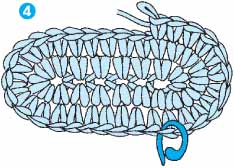
From here on out, you get to eyeball it. Keep an increase at the very end of each curve, and make the other two increases evenly spaced at increasingly wider distances from the center of the curve. It’s not rocket science: As long as the oval lies flat, you’re doing it right.
Q I’d like to work an oval in double crochet. How many increases do I need?
A A double crochet oval requires 12 increases every round (6 increases at each end).
Q I followed the chart, but my piece isn’t flat. What did I do wrong?
A This is a common problem. Here are some things you can check:
If your crochet is curling into a bowl shape:
You may not have started with enough stitches, or you may not have made enough increases per round.
Even though you are increasing sufficiently, you may be working the stitches too tightly. Loosen up a bit or try a larger hook. It is even okay to change hook sizes when stitches change within the same motif, if that’s what it takes to make it lie flat.
If the motif is ruffling:
You may have too many increases per round.
If after counting your stitches, you find your numbers are right, you may be working the stitches too loosely. Try a smaller hook.
Consider making each stitch slightly taller. For example, try an extended double crochet in place of a double crochet.
SEE ALSO: Pages 106–7, for extended crochet.
While the charts give general guidelines for working a flat motif, you may find you need to bend the rules a bit based on your crocheting style and personal preferences. Be assured that it is okay to add or subtract increases as you work, in order to have the piece lie perfectly flat. This is especially true on the bigger rounds when working larger pieces.
Q Can I use more than one kind of stitch when I’m working a flat motif?
A You can certainly mix stitch heights on your motifs. Just remember to change the number of increases accordingly. For example, you start a circle using double crochet stitches, increasing 8 stitches each round. If on one round, you want to use treble crochet, you must increase 18 times in that round in order to maintain a flat circle.
Q Is there another way to keep my pieces flat when I’m working in the round?
A If you prefer to be more relaxed about your stitching, you can be. Keeping in mind the guidelines above, experiment with doubling the increases every other round, or in some other arrangement. Remember that you can use a combination of chains and stitches for your increases, and that you can use a chain-space in place of a stitch, as for a granny square. Just be sure to stop at the end of every round, place your piece flat on a table, look at the outside edge, and check to see that it remains flat. Be honest with yourself!
Turning a blind eye won’t help: If your piece is not flat on Round 3, it won’t correct itself on Round 6.
If you notice that the last round you worked is not quite right, sometimes it is possible to make adjustments on the following round without ripping out the problem round. If you aren’t happy with the adjustment round, stop! Rip out both rounds and get it right before continuing. (Voice of Experience: From someone who abhors ripping out stitches — sometimes it just has to be done.)
Q Where do I put my hook when working in rounds?
A When you work back and forth, turning the work at the end of each row, you put your hook into loops lying sideways just slightly to the left of the next stitch. On the other hand, when working in rounds without turning, you put your hook into loops lying sideways just slightly to the right of the next stitch.
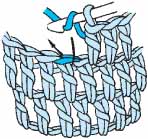
placement of hook when working in the ground
Note: If you turn your work to the other side, you’ll see this is the same spot you’ve been putting it in when working back and forth. The difference is that you are always seeing the right side of the fabric when you work in rounds.
Q How do I squeeze in all the stitches I need in the first round?
A Be sure you are not letting the bases of the stitches overlap one another. When they overlap, you can’t slide them around the ring easily. If they aren’t overlapping, yet there still is not room for them all, add one more chain to your beginning round or try one of the alternate beginnings described below.
Q Can I make a smaller center ring?
A To get a closed center, try these alternate ways of beginning a circle:
1. Leaving about a 6″ (15 cm) tail, wrap yarn into a ring around your finger as if to start a slip knot. Insert hook into ring.
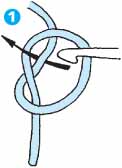
2. Yarn over hook. Pull up a loop. Proceed to work the first round of stitches into the ring as you would into a crocheted ring.
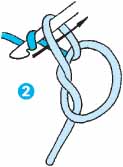
3. When you have the desired number of stitches on your first round, tug the non-working tail of the yarn to tighten the hole.
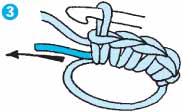
1. Chain 2, 3, or 4 (for single crochet, half double crochet, and double crochet, respectively). In effect, this is a turning chain plus one stitch.
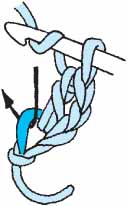
working into extra chain
2. Work Round 1 into the first chain you made. (You are working all the first round stitches into the extra chain.)
3. Pull tail to close center.
Q How can I improve the knot at the beginning of a circle?
A Try beginning with one of the knotless methods above, or instead of using the end attached to the ball when working the initial slip stitch, try using the tail end of the yarn.
Q What can I do to improve the slip stitch join at the end of a round?
A If you think the join is sloppy, try this alternate method of joining: Work to the end of the round, but before joining with a slip stitch, remove the hook from the loop. Insert the hook into the spot you want to join as if to make a stitch, pull up the loop you just dropped, and continue. If you still don’t like the way it looks, try it again, inserting the hook into the stitch from back to front and pulling through the loop.
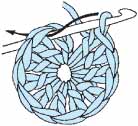
pulling loop through back to front
Q Why does my circle look like a spiral instead of separate rounds?
A When you work the rounds, you are probably failing to join the last stitch of round to top of chain at beginning of round. Although you sometimes may want to crochet a spiral, if not, be sure that you start each round with a beginning chain in order to raise hook to correct height. This beginning chain counts as a stitch. When you’ve reached the end of the round and made the appropriate increases, join round with a slip stitch to top of beginning chain.
SEE ALSO: Page 140, for stitch heights of beginning chains.
Q Do I have to use both a joining stitch and a beginning chain when working rounds?
A In crochet, you don’t have to do anything! Some circularly made items, both flat and cylindrical, are worked in continuous flat spirals. Be sure to place a marker to help you identify the end of the round.
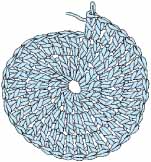
spiral
Q How do I find the end of the round?
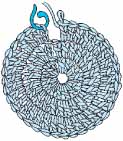
placing a marker on a joined round
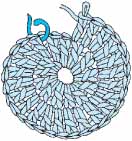
placing a marker on a spiral round
A If you are joining rounds, put a stitch marker in the top loop of the chain that begins the round. If you are working without joining rounds, slip the marker onto the first stitch of the first round. The next time around, when you work a stitch into the marked stitch, move the marker into the new stitch, and continue to move the marker on each subsequent round.
Q Why isn’t my circle exactly round?
A You may be stacking the increases on top of each other on each round. Try moving the increases so that they occur at different places on each round.
Q What’s the difference between any old square and a granny square?
A The familiar granny square is a special form of square motif. Although there are many variations on the granny square, the traditional one is a double-crocheted square made with a series of chains and double-crocheted blocks — a kind of filet crochet in the round.
Granny squares can be worked with any number of colors. They are a great way to use up scraps. They can be made with any size yarn and hook, and can be made with any number of rounds. Make a single granny square big enough and you have an afghan!
Q How do I make a granny square?
A You could just follow the general instructions above for a double-crocheted square, but since granny squares are so popular, I’ll make it easy for you and give you a pattern.
With MC, ch 4, join with a slip stitch to form ring.
RND 1: Ch 3 (counts as dc), 2 dc in ring, *ch 1, 3 dc in ring; repeat from * two more times, ch 1, join to top of ch-3. Cut MC and end off.

RND 2: Attach CC in any chain space. (Ch 3, 2 dc, ch 1, 3 dc, ch 1) in chain space, *(3 dc, ch 1, 3 dc, ch 1) in next space; repeat from * two more times, join to top of ch-3. Cut CC and end off.
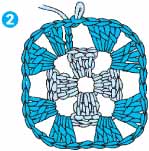
RND 3: Attach MC to any space between groups. (Ch 3, 2 dc, ch 1) in chain space, *(3 dc, ch 1, 3 dc) in next space, ch 1; 3 dc in next space, ch 1, repeat from * two more times, (3 dc, ch 1, 3 dc) in next space, ch 1, join with slip stitch. Break MC.
See how you are increasing 3 stitches in each of the four corners, Q with groups of 3 dc in each chain space? With each additional round, you continue to work increases in the corners separated by groups of 3 dc in between. You can continue doing that ad infinitum.
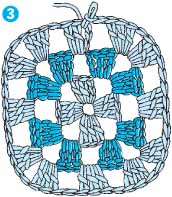
Q I like the way granny squares look, but I don’t like all those yarn ends. What’s a good way to manage the ends when working multicolored motifs?
A Work them in as you stitch. When you start a new round in a new color, leave about 6″ (15.2 cm) of the old color. Hold the tail of the old color at the base of the next stitch. As you insert your hook to make the next stitch, work around the tail of the old color. Do this for several stitches until you think the tail is secure, then drop the old color tail. You can go back and trim the ends later.
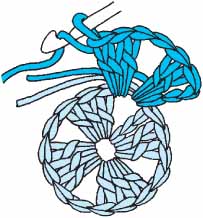
working tails in as you stitch
Q Are there other kinds of squares?
A There are hundreds of variations of square motifs, as well as circles and hexagons. Entire books have been written on the subject. Once you are familiar with the concept of making flat motifs, you’ll want to design your own.
Q How can I get more pronounced points at the corners of my motif?
A Try placing a taller stitch in each corner stitch of the motif. In other words, if you are making a double crochet square, place a treble crochet in place of the center double crochet in each of the four corners. If the corner is made with a chain, make one extra chain. Experiment, as you may not need to make this adjustment on every round to get the look you want.
Q I tried making a semicircle by working back and forth and adding half the number of increases per round needed for a circle, but the straight edge wasn’t straight. Why?
A The tops of the stitches have room to spread out when you work this way, whereas in a full circle, they are crowded together and thus forced to stay in place. To solve the problem, make sure your increases are not at the edges of the semicircle, and use fewer than half the increases you would use for a circle in that stitch. For a double crocheted semicircle, crochet as follows:
ROW 1: Beginning with one of the closed-center starts described above, Ch 3 (counts as dc), dc 5 the first row, turn. [6 dc] (This is one-half the number of stitches required for Round 1 of a double crochet circle.)
ROW 2: Ch 3, 2 dc in next dc and in each dc across, turn. [11 dc] (This is one less increase than you make for a dc circle, resulting in fewer than half the stitches required for Round 2 of a dc circle.)
ROW 3: Ch 3, (1 dc in next dc, 2 dc in next dc) 5 times, turn. [16 dc]
ROW 4: Ch 3, (1 dc in next 2 dc, 2 dc in next dc) 5 times, turn. [21 dc]
Q I want to work a three-dimensional shape in the round. Is it possible to crochet a tube?
A Certainly! Crochet a foundation chain with as many stitches as you need for the circumference you desire. Making sure the chain is not twisted, insert the hook into the first stitch of the chain and work a slip stitch to form a ring. Work a beginning chain to raise the hook to the appropriate height, then work into each stitch around. At the end of the round, join with a slip stitch to the top of the turning chain. Repeat this round for as many times as required to get the desired length.
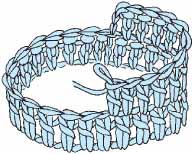
crocheting a tube
Q My tube isn’t straight. What makes it skew?
A This is a common problem, inherent in the stitching. It happens because the stitches are not exactly on top of each other. Because you are working in the same direction all the time, there is no opposite pull on the stitches to straighten them out. You can prevent the skewing by turning your work after joining at the end of each round.
Q How can I make my motifs crisp and neat?
A There are a couple of refinements you can make in order to make tidier motifs:
Instead of starting each round in the same place, end one round and start the next one in a different spot. This prevents the chains from stacking on top of one another, and works especially well when you are changing colors on each round.
You can avoid stacked chains by starting new yarns without a chain, instead of using beginning-of-the-round chains.
SEE ALSO: Pages 54–55, for joining a new yarn.